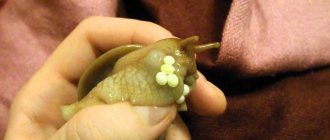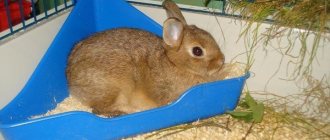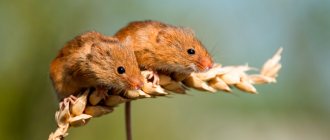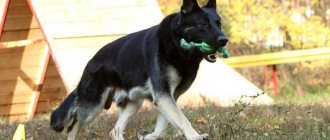How do Syrian hamsters reproduce?
Most hamsters reach sexual maturity at 6 weeks of age, although some can breed as early as 21 days old. It should be understood that at such an early age the offspring will be quite weak, since the animal’s body is not fully developed.
Pregnancy in young females often provokes the appearance of rickets and other complications both in her and in the offspring. Very often, females who become pregnant at the age of several weeks completely eat their offspring. Thus, it is best to mate hamsters when they reach 5-6 months of age. It should be understood that it is necessary to fit into these terms, since at a later age pregnancy can cause complications in the female.
Did you know? European hamsters are considered the largest representatives of their species. Adults reach 35 cm in length.
Experts say that at least 3-4 months must pass between two matings, during which the female has time to regain strength after the previous pregnancy. Without such an adaptation period, subsequent offspring are very weak or may not survive at all. It is best that the second mating occurs already at the 10th month of the female’s life, since closer to the age of one year she may partially lose the ability to reproduce. As for males, such problems do not arise with them: the possibility of mating appears already at the age of one month, in addition, they retain the ability to produce offspring throughout their lives.
Syrian hamster: description
The Syrian hamster is the result of crossings of various species, and quite rare, wild hamsters. This animal was accidentally discovered at one time in Syria. Adult individuals are characterized by medium size.
Adult specimens grow to a maximum length of 13.5 cm, while their tail is only one and a half centimeters long. The maximum weight of adults is about 250 grams, with females being slightly larger than males. Despite this, Syrian hamsters have a short but strong body.
The animal's coat consists of soft and fairly thick fur, which is painted in golden tones. The characteristic habitats of these animals in nature are the areas adjacent to the city of Aleppo, as well as the eastern territories of Turkey.
Interesting fact! The front paws of this animal have four toes, and the hind paws are armed with five toes.
The muzzle is characterized by the presence of rounded shapes, and as for the ears, they are small, as is the tail, which is barely noticeable due to the rather thick coat. There are both long-haired and short-haired species.
How long do Syrian hamsters live?
As far as we know, regardless of their habitat, be it the natural environment or being in captivity, hamsters live no more than 3 years.
Under certain conditions, by providing the animal with balanced feed, you can extend the life of your pet, although only slightly.
Breeding rules
There are two types of hamster breeding. The first of them is accidental, for example, when you purchased a female at the market or in a specialized store, and she gave birth within a few days, since she was already bearing offspring (you just didn’t know about it). It also often happens that a store offers two hamsters at once, claiming that they are same-sex. Subsequently, it turns out that they were a male and a female, and over time they gave birth to offspring.
Also find out how Syrian and Djungarian hamsters differ and which one is better to get.
The second option is the deliberate breeding of hamsters, which is carried out with the aim of producing offspring for sale. In this case, the owner of the animals is the breeder, and it is necessary to take into account several factors that affect the condition of the male and female after fertilization:
- Hamsters of different sexes get along very poorly in the same territory, so they must be kept in different cages, bringing them together only for the sake of reproduction on neutral territory (the whole process must be monitored).
- As for mating, both hamsters must be at least 4 months old. If this is not the female’s first offspring, the male may be much younger.
- It is not recommended to mate if the female is already more than 12–14 months old, as in this case there is a risk of complications and the appearance of a dead offspring.
How to equip the premises
It is advisable to purchase cages and equip a small room for Syrian hamsters before purchasing the pets themselves, so that they do not undergo adaptation in uncomfortable conditions while you take care of purchasing housing.
Important! Up to 20 individuals can be inside the room with cages, but the air temperature in it should not exceed +25°C. If necessary, it is recommended to equip the living space in which the cages are located with air conditioning.
It is also necessary to ensure that hamsters are not distracted by various sources of noise. Drafts or direct sunlight are also undesirable. All this negatively affects the reproductive function of animals. As for the cages themselves, they should be as spacious as possible, and also have a drinking bowl and a running wheel inside. This will prevent cases where the hamster becomes depressed due to the fact that he does not have enough space or simply has nothing to do.
It is imperative to seat adult males and females separately, as well as young animals.
Additionally, take care of purchasing a carrier in which you can place the individuals during mating. You also need to buy small cages for the young animals in case you are not able to immediately place the cubs with new owners. The young animals get along quite poorly with each other in the first weeks.
Buying rodents
When purchasing animals, it is advisable to request information from breeders regarding the genetics of rodents. If you decide to start with one pair, it is best to purchase a male and female from different pet stores, otherwise they may turn out to be brother and sister. Often sellers assure buyers that this is not so, but the truth is revealed already with the first litter, when the cubs that have given birth are too weak. It is best for hamsters to belong to different branches of their species. This will avoid possible genetic disorders.
Important! It often happens that a male and a female have a fairly good exterior, but genetically they are absolutely not suitable for each other. That is why it is worth purchasing several pairs at once, so that later you can mix them together.
Reproduction process
Before you begin organizing the process of mating two Syrian hamsters, it is necessary to determine when the female’s estrus period begins. It occurs every 5 days and lasts from several hours to a day.
An attentive owner can determine this period by the following signs:
- a sharp musky odor emanates from the female;
- viscous mucus appears in the genital area;
- the animal behaves quite restlessly, rushing from corner to corner;
- the female shows a lack of appetite;
- constantly makes specific sounds.
This behavior is not observed in males, because they can mate regardless of the period of the day or days of the month. Their reproductive function “makes itself felt” already from the second month of life.
Since mating cannot be carried out on the territory of a female or male, you should take care in advance of a separate cage or cardboard box in which mating will take place. If you were unable to track the “girl’s” estrus period, then there is a high risk that a conflict will occur between her and the male (they will start fighting). In this case, be sure to have a pair of gloves on hand to separate the hamsters.
If you managed to choose the right time for mating, the female will be absolutely friendly, and the mating process will last only 10–15 minutes. After this, the animals are immediately seated in separate cages. You can determine whether a female is pregnant by whether she goes into heat 5 days after mating. If there are no signs described above, then the animal is pregnant.
Read more about how to breed hamsters at home.
How do Syrian hamsters reproduce at home?
Caring for a hamster is very simple, even children can handle it. You just need to explain all the nuances of feeding and care. Breeding Syrian hamsters at home requires responsibility and care.
Room equipment
It is necessary to choose a place to place the cage so that it is spacious, away from noise and dust. The cage should be located away from direct sunlight. It is necessary to frequently ventilate the room, but at the same time strictly avoid drafts.
In order for the reproduction of Syrian hamsters to be successful, it is necessary to prepare several cages:
- A large and spacious cage where the female will be with her offspring after giving birth. In this cage you need to equip a queen cell where the birth will take place. You need to add a small layer of sawdust to the bottom. It is extremely necessary to arrange an active area so that there is a place where kids can frolic. The spinning wheel, rungs and ladders are perfect for outdoor activities.
- Cage or box for mating. Here you can get by with a small box; it needs to be free of distracting objects (wheels, ladders). You can add sawdust or special filler to the bottom. It is important to place the box where it is inaccessible to children, cats, dogs and other pets.
- An additional cage where, if necessary, the Syrian hamster can be placed in case of any aggression from other animals.
Purchasing rodents
A lot depends on the choice of partner for mating. Breeding Syrian hamsters is a responsible matter and must be taken seriously so as not to endanger the lives of the entire Syrian hamster family. A pair of the opposite sex should be of the same breed as your pet. Hamsters should not be closely related to each other, otherwise brother and sister may produce weak offspring with signs of pathology and physical inferiority.
It is important to be able to distinguish a male Syrian hamster from a female. Only healthy rodents without diseases or transmittable infections are allowed for mating. The coat of the purchased animal should be shiny, thick and without bald spots. The eyes and nose should be clean and free of discharge. It is also worth paying attention to the emotional state of the hamster. In a normal state, the animal behaves actively, showing interest in everything new, without being afraid of an outstretched hand. However, too energetic behavior of an animal should alert you, as well as too apathetic behavior.
To give your pet time to get used to a new territory, you need to buy a Syrian hamster at a young age. After purchasing a partner, hamsters should be kept separately from each other so as not to suffer as a result of aggression from the partner. Mostly females show aggression, not allowing the male to approach them. They are favorable to their partner only during estrus, which lasts 3-4 days.
Syrian hamster: reproduction
Syrian hamsters reach sexual maturity when they are between 1 and 2.5 months old. But at this age it is not recommended to mate, since the delayed physical development of the female can negatively affect the bearing and feeding of offspring. The female may not have enough milk for large offspring. Therefore, it is worth involving a female in breeding for the first time no earlier than when she reaches three months of age. If your first birth occurs after she is six months old, there is a risk of complications during pregnancy and childbirth. The male is capable of healthy fertilization at the age of 3 months to one and a half years.
Before mating begins, you need to find out when the female is in heat; it is on such days that you can place a male with her. The main signs of estrus in a female Syrian hamster are similar to other animals. She becomes more active than usual and can stand up, arching her back and spreading her paws. Under the tail you can notice a mucous discharge with a pungent odor. Syrian hamsters are nocturnal animals; they are active mainly at night, including mating. Estrus can begin in the evening and last until the morning. It is necessary not to miss this moment and place a male with her. The next chance will be only in 4-5 days. If you are sure that the right moment has come right now, you need to carefully bring the male to the female. After sniffing each other, the girl can stand up, thereby showing her consent. Now you need to leave the couple in a quiet, calm place for the duration of mating and not disturb them. Half an hour will be enough for conception; during this time you need to be careful and, if the female becomes aggressive, immediately isolate the male from her. There have been cases when a female bit her partner to death.
What to do after mating
Hamsters are quite sociable animals, but despite this, the male and female should not be in the same cage, especially after pregnancy has occurred. During this period, the hamster cannot be in the same house even with individuals of the same sex, as they can easily harm her. It is necessary to constantly ensure that the animal has fresh food, water and dry bedding. You also need to carefully monitor the pregnancy process and note whether the animal exhibits strange and uncharacteristic behavior.
What to feed your Syrian hamster
The Syrian diet in nature consists of:
- Seeds and cereals (the basis of rodent nutrition)
- Herbs
- Insects
In your home life, also try to adapt to this list.
A mixture of grains and seeds is the main thing you need to give your pet. An excellent option is ready-made dry food for hamsters. If the manufacturer has enriched the composition with vitamins and minerals, even better.
We suggest you read: Is it possible to keep degus at home or not?
If you yourself prefer to control the composition of the food, and caring for the animal gives you pleasure, here is a simple video instruction for preparing the mixture. The most common set is oats, millet, corn, and some seeds.
You can also add some nuts to the food (except for almonds and Brazilian almonds - they contain a high concentration of substances dangerous to rodents).
The Syrian hamster will also benefit from greens (lettuce, dill). Eliminate onion and garlic shoots and sorrel from your diet.
In season, add fresh vegetables, fruits and berries to your menu. But this should be done carefully. The Syrian is not as prone to diabetes as the Djungarian, but still avoid overly sweet fruits and starchy vegetables. Use the glycemic index table of foods - very useful information for those who care for the Syrian animal. Try not to give foods that have a GI of more than 50 - an excess of easily digestible carbohydrates.
Don't forget about protein. Buy ready-made dried insects or feed your pet 1-2 times a week with the following products of your choice:
- Egg white
- Boiled chicken breast
- Boiled lean white fish
Lactating and pregnant females, as well as their offspring, need special care and more protein - give protein foods a little daily.
We talk in detail about what you can and cannot feed your golden hamster in a separate article on the website.
Berry in season is an excellent addition to the diet.
In the wild, this species lives in meadows and steppes, so it should be fed with fresh grass, seeds and mixtures. You can mix corn, buckwheat, oatmeal, and flax yourself. Small insects, worms and other protein foods are also good for your hamster's health.
The baby's body must receive vitamins, so add fresh herbs, fruits and berries. Lettuce leaves, nettles, dill, and parsley are suitable. Syrians love to chew nuts, apples, zucchini, carrots, cucumbers and turnips. To grind down the incisors, you can use twigs of apple, cherry, birch and maple.
You should not feed your rodent dairy products, sweets and citrus fruits. Make sure that the animal does not overeat. A rodent's stomach may not be able to handle large amounts of food. If you are transitioning him to a new food, do it gradually. Make sure that the new food does not cause allergies in the animal.
Proper care of a Syrian hamster involves protecting the animal from stress. You cannot bring an animal and immediately put it on public display. Noises and a large number of new impressions can lead to illness. From fright, the baby may faint or bite its new owners.
Carefully place the animal in its new home and give it time to get used to it. An animal that feels insecure presses itself to the floor of the cage and moves slowly, looking around. If the animal has gotten used to it, it will quickly explore the house, run on a wheel and “dive” into the house.
To provide a rodent with a decent life in your home, you need a cage or terrarium no smaller than 60x40 cm. It must be equipped with a house, a wheel, shelters, a feeder and water bowl, a toilet, a bath with sand and a mineral stone.
The floor should be covered with sawdust about 2 cm high so that the animal can dig holes.
The hamster prefers solitude. He cannot stand the proximity of his relatives.
The list of foods includes dry mixture, greens and protein products. You cannot feed your baby table scraps. You will find a list of permitted and prohibited foods on the page dedicated to feeding the Syrian hamster.
"Syrians" are nocturnal animals. Their activity manifests itself in the evening and at night. This must be taken into account when choosing a location for the cage. Don't put it in the bedroom, it will be noisy at night.
The smell in the cage appears if the animal is not kept properly or the cage is rarely cleaned. Depending on the size of the animal’s home, the procedure is carried out from once every 3 days to once a week. When cleaning, remove spoiled food from your pet's supplies. Change the water in the drinking bowl daily.
The Syrian hamster is a lowland animal. The difference in height is dangerous for him. The animal easily steps into the void and injures itself when falling from a table or from a window.
Proper care for Syrian hamsters does not include water treatments. This desert animal does an excellent job of cleaning its skin on its own. To clean his fur coat, give him a tray with sand. Some animals enjoy rolling around in it.
An experiment was conducted to see how much hamsters run during the night. It turned out that the baby covers a distance of 6-7 km with an average speed of 2 km/h. In nature, this furry animal is capable of conquering distances of up to 12 km.
Another experiment involved running in a wheel. It turned out that during the night the animal ran from 6 to 10 km, with a maximum speed reaching 3.6 km/h.
Due to the high activity of the animal, it is necessary to purchase a running wheel or walking ball.
Gestational age
Pregnancy in this type of hamster lasts only 2-3 weeks. Most often, females give birth already on the 19th day after the expected conception. You can clearly see the signs of pregnancy already 10 days after fertilization. At this time, the hamster begins to rapidly gain volume, especially in the abdominal area. If the breeder notices that the female's weight is constantly falling, this may indicate that the animal is sick or that the embryos inside the womb have died.
Did you know? Scientists have proven that all representatives of the species diversity of hamsters are color blind - they cannot distinguish colors.
It is worth noting that pregnant females completely change their behavior. They begin to move very carefully and do not make any sudden movements. That is why you should not unnecessarily disturb the animal, so as not to frighten it. Otherwise, a miscarriage may occur. It is worth taking care of the female by providing her with more protein foods, for example, egg whites, cottage cheese, baby food or cheese. An imminent birth can be determined by the fact that three days before it, the female’s thirst increases. You should ensure that the water in the cage is changed every 2-3 hours.
How does childbirth go?
In most cases, the female begins to give birth at night. That is why you need to make sure in advance that there is a small nest in the cage, where the individual can arrange a place for the offspring. To do this, you need to provide her with soft paper, hay or napkins. The cage should be located several days before the expected birth in a quiet and peaceful place where no one will make noise and scare the hamster. In most cases, pets cope with the birthing process on their own, and the breeder sees the newborn in the morning.
Hamsters are born in a shell, which the female gnaws in the head area. At the same time, the animal takes its first breath. If this does not happen, the litter dies. On average, a litter contains from 4 to 16 hamsters. They are born small, blind and deaf, with very thin and sensitive skin. But at the same time, they perfectly distinguish odors. You should not touch animals with your hands immediately after they are born, as the female may refuse the offspring.
We advise you to read more about the information on how hamsters give birth.
If this is your pet’s first pregnancy, it is best to monitor the birth process in order to help the female in the event of the birth of a large number of cubs. It is better not to interfere with the birth process unless necessary, but there are some signs that indicate that help cannot be avoided:
- if contractions or attempts last for more than 15–20 minutes and are completely ineffective;
- if the first baby was born more than half an hour ago, and there are no other babies;
- if 30 minutes after the completion of labor the female refuses to eat and refuses to feed the babies.
Features of care and maintenance after reproduction
Immediately after birth and during the first 7 days after it, young animals should be avoided, observing them from afar. Otherwise, the hamster will smell someone else's scent and eat the offspring. To make the female and babies more comfortable in the cage, you can put a dry napkin or soft paper inside. The animal will use it to shelter its offspring when it needs to leave the nest to feed itself.
About 5-6 days after birth, the cubs begin to climb out of the nest and sniff the cage. They develop the ability to see only 2 weeks after birth, and that’s when they begin to eat “adult” food. This period must not be missed in order to provide them with all the necessary food. For example, boiled porridge or grated carrots are suitable. If the female does not have any health problems, she can feed the offspring with milk for up to 1 month. At the same time, the hamsters grow up strong and healthy.
It’s interesting to read how to choose a name for a Syrian hamster.
Within a month, the hamsters need to be placed in different cages - males separately from females. This is done so that they do not begin to mate with each other when puberty begins. The young animals need to live in their new home for up to 2 more weeks until they are fully strengthened. At the age of 1.5 months they can be sold to new owners.
As for the postpartum period in a female, it is imperative to monitor whether the vaginal membrane is healing 1-2 days after birth. It should close completely and stop bleeding. If there is persistent discharge for more than 2 days, you should contact your veterinarian.
Caring for a Syrian Hamster
Proper maintenance and care of a royal hamster consists of:
- Have a comfortable home
- Physical activity
- Hygiene
- Good nutrition
- Protection from stress
- Veterinary treatment
Recommendations for house size for the Syrian breed vary greatly, we will try to answer this question as simply as possible. Choose a cage of such a size that maintenance is easy and it can accommodate:
- House for the night
- Toilet
- Utensils for food
- Drinking bowl
- running wheel
We invite you to read: What to feed a British cat at home and what feeding plans are there?
Place accessories freely so that the toilet and eating area are as far apart as possible. Additional options in the form of a labyrinth or a second or third level will make the adult pet’s home more comfortable.
What to prefer: a cage, an aquarium, a terrarium or something else? The most suitable option is a cage, and it is easier to care for than other options. An aquarium of sufficient size is also good, but the cage has better air circulation. Good options include a terrarium or a homemade glass shelving unit.
Do not keep your Syrian hamster in a jar or cardboard box. They are too crowded and the small rodent has to sleep in its own excrement. And the lack of “sports equipment” will greatly affect the baby’s health (we will cover this issue a little lower).
Place the house in a quiet place - caring for a Syrian rodent involves the absence of noise. Sudden loud noises will cause him stress and possibly inappropriate behavior. Those. the living room and kitchen are not suitable. The bedroom is also not an option: the hamster is a nocturnal animal and will not let you sleep. One way out is to leave the cage in the bedroom during the day and move it to the living room at night.
In the wild, a hamster runs up to 12 km per night - there is no feeder, and food must be looked for. At home, with proper care, there is plenty of food, it’s not far to run for it. As a consequence - obesity and all the ensuing consequences (problems with the cardiovascular, endocrine systems, musculoskeletal system).
This is why wheels and labyrinths are placed in the cage. You can also use a special walking ball for hamsters.
We strongly do not recommend walking on the street. Open spaces, noise, sunlight will lead to severe stress after the comfort of an apartment. There is also the possibility of picking up parasites somewhere on the lawn or simply losing a nimble little one.
Luxurious apartment with a gym for a rodent.
The royal hamster will definitely equip a toilet in the house. You should not try to accustom him to a certain place - it will be easier to care for if you see where he chooses a latrine, and only then install a kennel and a bowl of food as far away as possible.
There should be filler on the floor of the cage, the layer thickness is 2 cm. Typically used:
- Sawdust
- Corn filler
- Granulated
- paper
Experiment for yourself, which is more convenient and fits your budget. Pieces of paper are a cheap care option, but choose ones without fragrances or other additives. Your pet may develop allergies, and in the worst case, poisoning when he tries to eat the bedding. The main thing is not to use cotton wool or other fibrous materials - the baby may simply get entangled and even suffocate.
The filler also requires regular maintenance - change it at least once a week, preferably 2. You can read in detail about how to choose a filler and how they differ in a separate article on the website.
At least once a week, clean the cage and do a wet cleaning. When caring for the house, do not use detergents with a strong smell - the Syrian hamster may refuse to return to the house. Don't forget to take care of your pet's pantry: don't throw everything away, but remove perishable foods.
The correct “ground floor” of the house with bedding.
About bathing a hamster
The care and maintenance of the Syrian hamster raises many questions among breeders. These animals have an easygoing disposition, maintain personal hygiene and cleanliness in the cage, and therefore do not require special care. It is unacceptable to keep the animal in a glass jar and feed it food from your table. Care and maintenance at home requires the following:
- The cage or aquarium must be appropriate for the size of the animal. In a small area, a Syrian feels uncomfortable, which can cause him to develop health problems.
- Feed the animal only high-quality food. You can buy specialized food at a pet store or make your own mixture of cereals. You should not give food that is starting to spoil.
- There should be clean drinking water in the cage. It needs to be changed daily.
- It is better to use hypoallergenic material as bedding that absorbs moisture and unpleasant odors well. Scraps of fabric and scraps of paper do not block unpleasant odors well, so it is better to use pine sawdust or corn filler. They not only absorb moisture, but also repel small insects. The filler should be poured in a layer of 2 cm so that the hamster can dig holes.
- Keep the cage and area clean. Twice a week you need to wash and disinfect the cage, remove leftover food, change the filler, and ventilate the room.
- There should be no sources of loud sounds or strong odors in the room where the animal’s cage is located.
- The Syrian himself monitors the cleanliness of his fur, so he cannot be bathed.
- Take your rodent to the veterinarian periodically. Many diseases, although they do not have pronounced symptoms, are very dangerous for the life of the animal.
If you are wondering how to care for a Syrian hamster, remember that the main thing is the cleanliness of the cage and a high-quality, balanced diet.
If you have already decided to get a cheerful Syrian, then first buy a suitable cage for him. Its optimal size should be 40 by 60 cm, with a plastic tray (not wood!) and metal rods. Of course, if you wish, you can purchase a more spacious home for your pet.
To keep your rodent healthy, you need to do a thorough cleaning of its cage once a week.
But, regardless of your final choice, the following mandatory things must be present in the hamster cage:
- bedding, it is placed under the bottom of the cage and acts as an absorber of all unpleasant odors emitted by rodents, in no case should you use cat litter, newspaper or a rag as a toilet, this can worsen the health of the hamster, it is better to use special litter for rodents (for example, for chinchillas) in the form of pressed sawdust;
- a wheel with a solid bottom, as well as with transverse protrusions, it must be selected for a specific individual;
- manholes, their role can be played by various branches, roots and tubes;
- drinking bowl, Syrian hamster do not absorb too much water, so the average container volume is approximately 50 ml, the water should always be fresh and at room temperature;
- house, it is better to purchase those dwellings that the animal cannot move on its own; for these purposes, special holes for hamsters are sold with attachment to the walls of the cage;
- feeder, as in the case of a wheel, this household accessory for your pet should be selected based on the size of the Syrian hamster; the width of the feeder can reach up to 10 cm.
We suggest you familiarize yourself with: Domestic degu squirrel, a small rodent from Chile
In order to keep your rodent healthy, you need to do a thorough cleaning of its cage once a week, including its equipment and iron bars. Everything must be thoroughly cleaned and disinfected with regular soap or baking soda. You should definitely remove the food in the hamster’s house that he hides in reserve, as it may already be spoiled.
The Syrian hamster is by nature a very timid creature: it can suffer shock or stress for what the owner thinks are common reasons:
- the appearance of a neighbor in an animal’s cage, this breed does not belong to school rodents, so they often get into fights with each other, winning their territory, even females after mating prefer to live separately from the male;
- a trip from a pet store to a new home, during the movement the animals can huddle in a corner and not stick out of it, even after arriving at the place, after the hamster finds itself in its new house, it is at first confused and can sometimes rush from corner to corner, pitiful food, but after some time this shock will pass, and the fluffy newcomer will begin to intensively arrange his home;
- sleep disturbance, it is better to place the cage with the animal in a room where there is little noise and no drafts;
- changing the location of the cell.
Why you shouldn't breed hamsters
Before you start breeding hamsters, you need to decide for yourself whether you are ready to devote enough time to caring for rodents. You need to think about all the nuances before purchasing the first pair of animals, because then it will be difficult to understand where to put the offspring.
Very often it is not possible to sell pet rodents profitably, and the owners simply take them to the market or to pet stores. In the latter case, one can only hope that the animals will not become food for the snakes. That is why hamster breeders are, first of all, people for whom this business is a kind of hobby and only then a business. Below are the main problems that breeders face in the first months of breeding hamsters.
We recommend reading which is better to get - a rat, a hamster or a guinea pig.
Affects the health of the female
Quite often there are situations when a pregnant female weighs less than 120 g. In this case, it is very difficult for her to give birth, and she may even die during childbirth. This happens if the partner with whom mating took place was much larger. It is also impossible to avoid pathologies of the birth process with rodents that are older than 14 months. Although hamsters live up to 3-4 years, the rest of their life after a year is considered old age for them.
In addition, it should be remembered that during bearing and feeding their offspring, females lose up to 30% of their body weight. If the animal was initially small, there is an increased likelihood that the body will be completely exhausted and the animal will die. Even if such a female manages to survive, she will no longer be able to reproduce.
During pregnancy, the female cannot act as a pet
It is also worth understanding that, being “in pregnancy,” the female is not a pet with whom you can constantly play. The last week before giving birth is a period when the hamster needs complete peace and quiet. Also, she should not be picked up in the next three weeks after birth. Otherwise, she may not recover or eat the offspring.
It is worth understanding that if you get a hamster for a child, then it will be very stressful for him to see how a hamster kills her children. This should definitely be taken into account by parents who decide to have a furry pet in order to teach their child to be independent.
It is useful to know the rules for taming a Syrian hamster.
Even if the young animals are already covered with fur, and you decide to pick up the rodents, you should not give them to children first. First, you need to accustom the rodents to the hands of adults, since small hamsters very often behave aggressively, bite and try to slip out of the hands. Adults will have to make enough efforts to make the young animals socially adapted.











